Mid Life Surgery!
Planning the Hull Modifications
Planning the changes to the hull is an interesting exercise. To be quite honest I hadn't really thought it out in great detail until we had the boat upside down in Bloodaxe' workshop. The basic aims of the changes are to add some more rocker and some buoyancy in the middle to reduce wetted area and improve light to moderate wind performance. All well and good. But exactly how much? Andy Paterson and I put a batten on top of the hull, and the real suprise was how little extra rocker it took to change it from a very flat boat to a rather rockery one. 50mm extra on the keel was enough to give it a definite hint of banana... I think I shall go for 40mm extra rocker. Then there are issues to do with section shape. Its tempting to go for a definite turn up to the chine to reduce the effective waterline beam when the boat is both heeled in very light airs and sailing at high speed. But there will also be a tendency for the boat to be wide at the transom compared to mid length if we do that, and that's not generally considered good for manners downwind. And its not excessively well mannered on a run anyway, though the rocker will help. So I'm puzzling over whether we can do anything with the transom that I'd originally planned to leave unchanged. But that starts to get very complicated on the surgery.
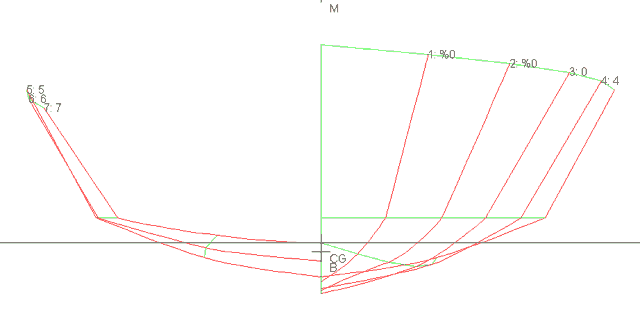
Anyway, for what its worth the above is what we're working to. The main change is the increased rocker, but there is also more curvature in the sections in the middle of the hull which is intended to help reduce wetted area. To an extent this is somewhat theoretical because this sort of surgery is difficult to make an exact science without putting in a lot more time and effort than I'm prepared to. The main thing is to get the pricipal sections correct and then get the hull fair, because fair is everything!
More thoughts on Mk 1a
The mid life upgrade is beginning to look like autumn/winter
2001. I'm gradually putting together a list of jobs. However I'm still
undecided as to exactly what to do to the hull. More rocker goes without
saying 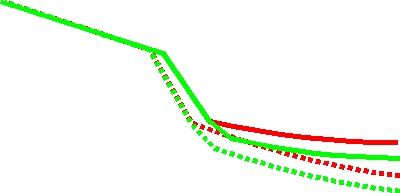 - as does no major changes beyond
the inner skin of the shell, because otherwise its practically building
a new hull. But really, the more I think about it the more I believe I
should have gone narrower on the waterline. Andy Paterson told me that
right from the start. I've discussed this a bit more in updates to the design page. The decision here is whether to
simply put more rocker in - basically build up the middle of the boat -
or whether its actually possible to reduce the waterline beam a
fraction. I rather fear - no doubt Mr Paterson will have some good
advice on this - that so much structure would be required as to make
this impractical, but I wonder if one could add quite a lot of material
to the bottom of the hull and give the boat a little mini double chine
section from, a little before mid length back This little sketch shows
the original section in red and the revised section in green, both at
the transom and (dotted) at the daggerboard. The alternative is just to
add material at mid length, and leave the transom unchanged, which is a
far simpler and smaller job, reduces the wetted are but doesn't do much
for waterline beam.
- as does no major changes beyond
the inner skin of the shell, because otherwise its practically building
a new hull. But really, the more I think about it the more I believe I
should have gone narrower on the waterline. Andy Paterson told me that
right from the start. I've discussed this a bit more in updates to the design page. The decision here is whether to
simply put more rocker in - basically build up the middle of the boat -
or whether its actually possible to reduce the waterline beam a
fraction. I rather fear - no doubt Mr Paterson will have some good
advice on this - that so much structure would be required as to make
this impractical, but I wonder if one could add quite a lot of material
to the bottom of the hull and give the boat a little mini double chine
section from, a little before mid length back This little sketch shows
the original section in red and the revised section in green, both at
the transom and (dotted) at the daggerboard. The alternative is just to
add material at mid length, and leave the transom unchanged, which is a
far simpler and smaller job, reduces the wetted are but doesn't do much
for waterline beam.
That's fine, and that would keep Bloodaxe busy, but there will also be some jobs for me. I'm increasingly sailing the boat with more bow down trim upwind, which in the present configuration can only be achieved by sitting out right on the forward corner of the wing, with the whole body leaning towards the bow, from toestraps which start about a foot or so aft of the front bulkhead. This isn't especially comfortable, particularly the corner! In addition the buoyancy in the ends of the wings is greater than I think is really needed (now?) and contributes towards the boat inverting readily.
So I'm going to remodel the wings a little. The two tasks will be
to reduce the size of the foam buoyancy and to 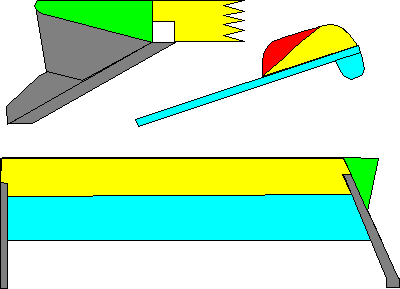 extend the wings forward towards the bow.This
is shown in these most definitely not to scale (even with each other)
sketches. The red shows the buoyancy I propose to remove, making a
smoother transition onto the wing, which should aid sitting out. Yellow
is the revised buoyant area, blue the existing main wing structure, and
gray the wing supporting beams. Green is the extension forward of the
wings. It won't be possible to make very much of an extension, because
the extension will need to be aft of the shroud in order for the wings
to pivot into the boat for launching, travelling and just sitting under
the cover in th dinghy park. However together with the rocker changes,
and extending the toe straps forward, it should be possible to position
the crew weight a good 6 inches further in front of the centre of
buoyancy than is possible now, which will significantly increase the
choices available for fore and aft trim upwind. You'll note that the
extension is also angled up appreciable. More dynamic lift when the wing
touches can only do good by resisting any tendency to dig in. Its a bit
cleaner in aerodynamic drag terms too, if surely not enough to make any
significant difference.
extend the wings forward towards the bow.This
is shown in these most definitely not to scale (even with each other)
sketches. The red shows the buoyancy I propose to remove, making a
smoother transition onto the wing, which should aid sitting out. Yellow
is the revised buoyant area, blue the existing main wing structure, and
gray the wing supporting beams. Green is the extension forward of the
wings. It won't be possible to make very much of an extension, because
the extension will need to be aft of the shroud in order for the wings
to pivot into the boat for launching, travelling and just sitting under
the cover in th dinghy park. However together with the rocker changes,
and extending the toe straps forward, it should be possible to position
the crew weight a good 6 inches further in front of the centre of
buoyancy than is possible now, which will significantly increase the
choices available for fore and aft trim upwind. You'll note that the
extension is also angled up appreciable. More dynamic lift when the wing
touches can only do good by resisting any tendency to dig in. Its a bit
cleaner in aerodynamic drag terms too, if surely not enough to make any
significant difference.
Mark 1A
Jan 2001
I'm seriously considering some fairly major surgery. The object of the
exercise would be to gain some more lighter airs performance at the cost
of a little high end speed. I've discussed this with Bloodaxe, and we're
of the opinion that this would be practical without too much weight
gain. What is being considered is to take off the entire floor skin, add
an extra layer or two of foam and reshape the keel line without changing
the chines. The object would be to add some more rocker. The advantages
of this would be a detailed below in the discussion of design changes
I'd make for a mark 2.
I guess that would be the second major change, the first one having been the new daggerboard. We rather overdid that one I think, I'm sailing with the thee board part up much of the time. Its quite interesting in that the amount of foil you need while the boat is sailing is very small, but you definitely need lots more while tacking.
The Mark 2!
June 2000
No, I am not about to build a new boat. This one will do me for a few
years yet. However only a fool believes that they have the perfect boat,
and this one was a significant step in the dark, and there's lots I have
learned.
What would I do Differently?
Hull Shape
Right or Wrong? Its basically OK, but there are some significant changes I'd make. The boat is a speed demon on a "apparent wind forward of the beam" reach, but is tricky to sail upwind and not especially quick on broad reaches and runs. It very readily dips the bow into the water, but with the flat inland waters isn't really interested in pitchpoling, although I've had one or two frights. So three changes
- More Rocker - probably under the centreboard case
- Chines swept up at the stem
- Mast eight inches to a foot further forward
The basic shape of the boat - especially waterlines - would remain much the same. I'm basically pleased with the way its worked out.
The rocker would help with the lighter airs situation I think, provided the wetted area was significantly lowered. In conjunction with the mast being further forward the boat could be more readily trimmed by the bow to lose wetted area in sub planing conditions. The upswept chines would provide a little more dynamic lift as the bow is immersed - and look prettier! I suspect the further forward mast position would also help with tacking.
I might be tempted to go narrower. The boat is in many ways easier to sail than I anticipated, although possibly more difficult to sail really well. Its certainly trickier to get going upwind than I hoped. The downside of going narrow is that weight carrying ability suffers, but as I now reckon I'll probably be the only person to build a boat to my rules, I don't have to consider this to the same extent.
I'm minded to consider angling the daggerboard aft considerably. The new large board helps a lot with tacking, but does take the edge off speed. Bethwaite talks a lot about "roll over vortexes" on angled sail luffs maintaining attached flow at high angles of attack. I wonder if the same thing could be achieved on a daggerboard so that one could have a high lift high drag situation coming out of a tack, which keeps the foil unstalled until the power comes on and the speed comes up. On reflection, though, I think this is a case for the mathematicians and tank test people to find out what works in theory. I don't fancy a daggerboard raked back 45 degrees! Anyone at Southampton Uni. reading this - could be an interesting project.
I have - just for fun - been drawing up an alternative version of
the hull with a bit more rocker - looking rather more like a Bethwaite
shape than the current one, which is (in my opinion!) more like a Murray
shape. Wetted area is lots better, but I can't get the prismatic
co-efficient anywhere near what I'd consider to be a reasonable figure.
I might play with this some more, but I shan't be building another boat
for a few years yet!
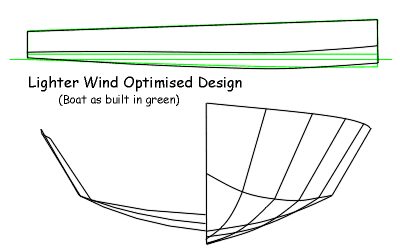
Rig
I'm basically happy with the rig, except that I really haven't got enough gust response. I suspect the top of the mast is too stiff. I'm beginning to wonder if we would be better taking up the Kiwi/Aus habit of building two part masts with separate tips. Certainly it would be a lot less trouble if you decided the top was too floppy. I guess this only really applies to the skiff type rigs where only the topmast bends though. However as this is such a rig it makes sense...
There might be some mileage in going bigger on the rig. It seems that I'm tending to carry the big rig in more and more wind, mainly because you suffer so badly in the calm patches. If the gust response can be significantly improved on what we have now - and I believe it can - then carrying more rag will become easier.
Wings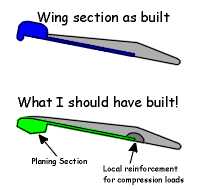
Flotation at the end of the wings was definitely a good idea.
However, mainly due to leaving things rather late on in the build
process, (like after I'd built most of the wings) I elected to put the
buoyancy on top of the wings to make nice curved seating. While this is
indeed comfortable, the big rise means that you have a
"quantum" increase in righting moment from sitting inside the
float to sitting on it. On reflection the flotation should have been
under the wing, and given a V section to form a planing surface. It
would need to be arranged so that the V was hitting the water evenly as
the wing touches the water with the boat heeled. Other than that I'm
pleased with the wings, and the hinge system works nicely.
The beams were a little under specified. I've had minor compression
failures where the front wing beam touches the deck. This was, of
course, highly predictable, and I should have dealt with it at the
design stage, rather than having to beef things up later. The lesson is
to look for significant point load areas, and both beef up the laminate
appropriately, and also consider having local areas of high density core
in order to distribute the loads better.
Mast Stump
Operationally this works fine, but grief, wasn't it trouble to
build, what with fitting bearing surfaces in etc. The advantage of this
is that there's much less surface for sand to bind on. On reflection,
though, I think that perhaps we should have moulded the whole bearing
surface round the spar, and then partially cut it away to reduce the
scope for sand binding. This single bearing surface would then have been
much easier to fit into the stump, rather than what I did, which was to
have 4 separate pieces to glue in. An alternative would be moulding the
stump round the mast and accepting a rather large surface for sand to
bind. Perhaps if slots were moulded in at intervals round the stump that
would have helped.
The track for the prodder has also been a problem. Although it hasn't
come loose - the carbon "straps" top and bottom hold firm, it
has come loose from the fillets in between. This means quite a gap as
the track bends away from the stump when setting the mast up with
prebend from the prodder. Of course these tracks are conventionally
riveted all the way down, but rivets in tension on a carbon spar aren't
necessarily a great idea (!) and in any case they'd be slap on the
bearing surface. I suppose, failing construction of a carbon track that
could be properly bonded onto the spar (thanks, but no thanks!), one
option would have been to have small s/s plates welded onto the back of
the track that could have been further bonded on to spread the tensile
loads.